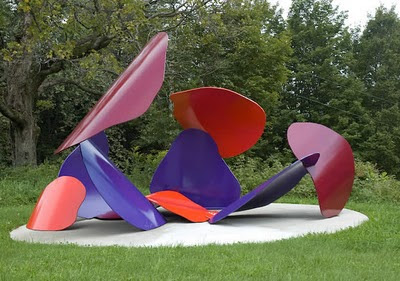
While at the Vermont Studio Center in September, working on a nonfiction project, I spent a wonderful afternoon with my former student, the essayist Sarah Stromeyer and her husband, sculptor David Stromeyer, walking the acreage adjacent to their home, viewing David’s stunning work. That field, in Enosburg, is testament to his long and innovative career working in metal. It was astonishing. He had to build, first, the means to make these exquisite things — tons of steel, cut, shaped, intricately assembled, moved — each and every stage an almost insurmountable engineering problem, and yet each looks light enough — or some of them do — to blow away in a strong wind. Not to mention the colors! And the way they take the light.
I visited David’s workshop and forge, where steel an inch thick or greater is bent, beveled, turned. A massive enterprise that begins with manipulating tiny cardboard models proceeds to mathematical modeling which must take into account the tensile properties of the materials, and the placement of bolts and welds must be accurate to the millimeter in order to make the whole thing work. Artist, mathematician, physicist, geologist, and engineer — David’s integrated understandings of these several disciplines make possible sculptures of an almost unearthly beauty.
Returning to my own work, the problems of composition appeared to me analogous: knowing how much weight a scene might bear, where and what kinds of transitions — like spot-welds — had to be placed in order to bring my themes together in unexpected but structurally sound ways, and how the various parts might be colored, i.e. emphasized or muted, in order to present a coherent and interesting whole. I remain grateful for David’s work on many, many levels.
